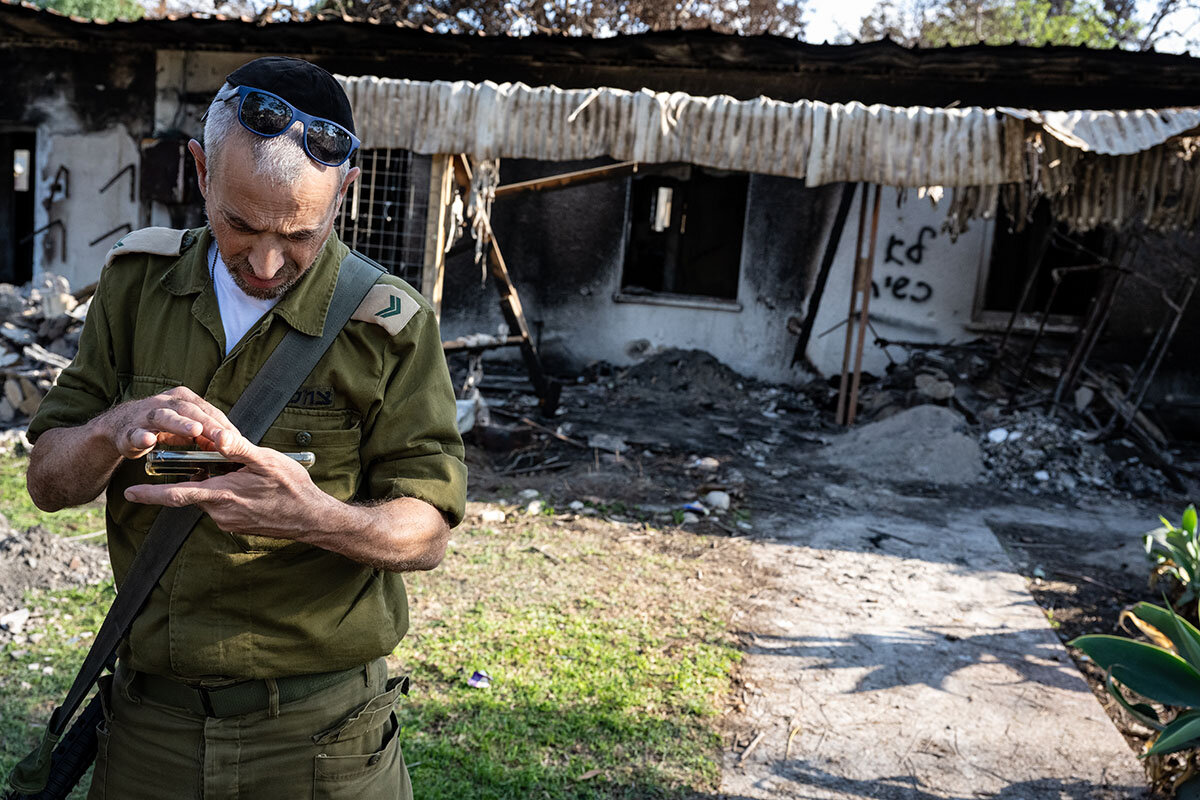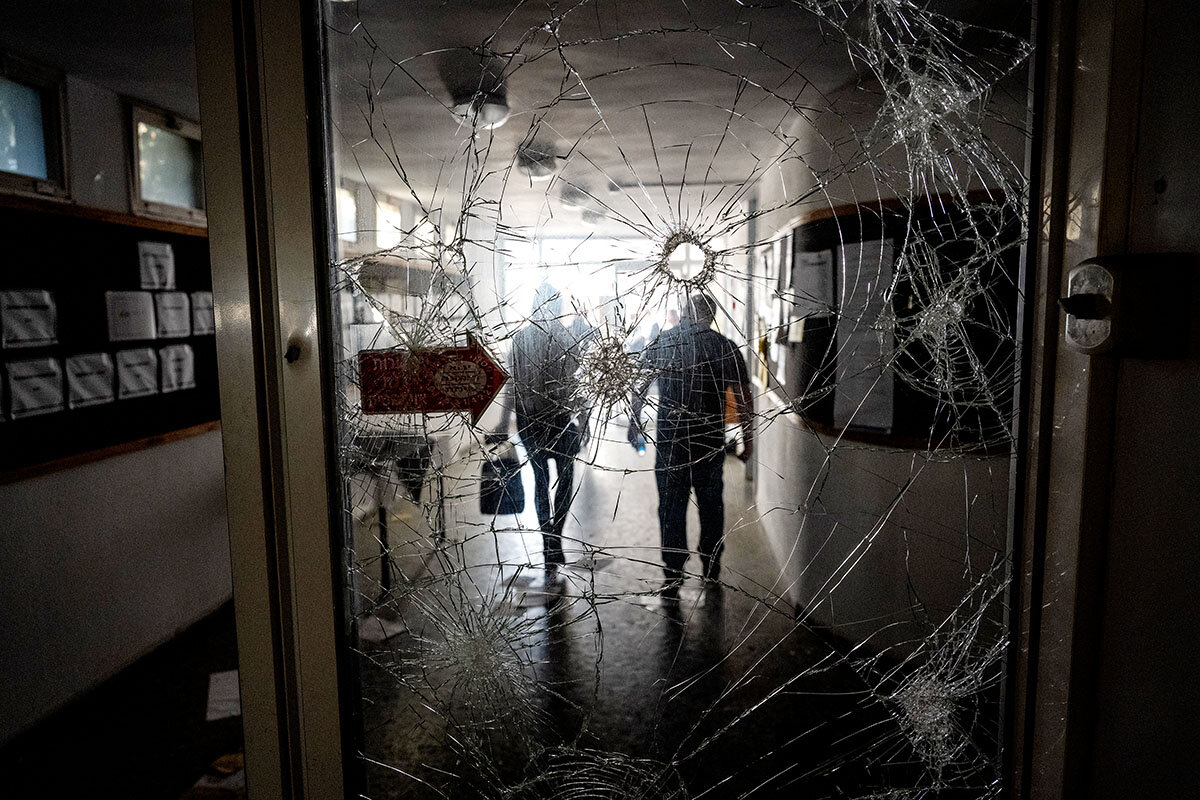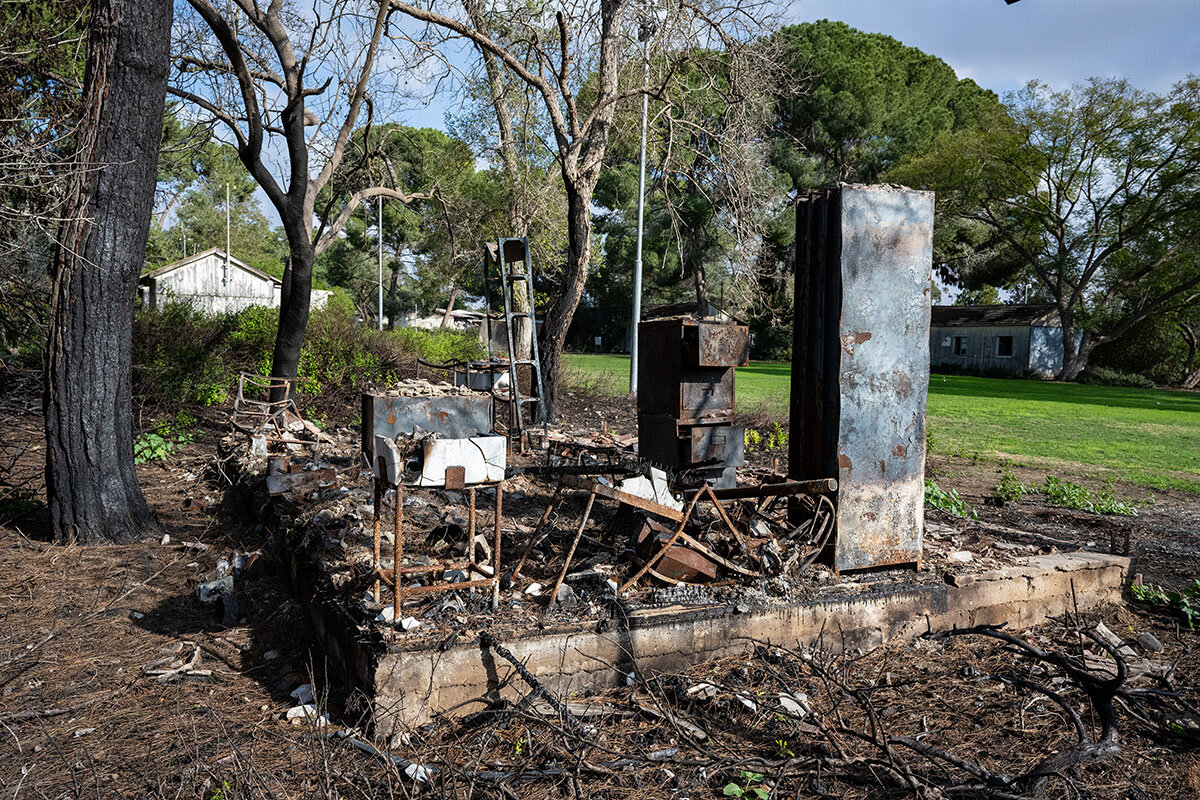At Oct. 7’s ground zero, what an Israeli survivor lost ... and learned
Loading...
| NIR OZ, Israel
Even as she grew up in this southern Israel kibbutz, a green oasis bordered by flat desert, Irit Lahav says she felt a latent, lurking fear of imminent attack, one that even permeated her piano lessons.
That is because the tall chain-link fence – crested with coils of razor wire – that encircles this collective community where she was born is just 1 mile from the impoverished and densely packed Gaza Strip.
The coastal enclave is home to 2.3 million Palestinians – most of them descendants of refugees uprooted by the creation of Israel in 1948 – as well as militant groups that for decades have been determined to destroy the Jewish state.
Why We Wrote This
A story focused onThe scene at a border kibbutz that was overrun by Hamas Oct. 7 shows the enduring physical and human damage from an attack that changed Israel, launched a brutal war, and deepened the challenge of achieving peaceful coexistence.
War erupted Oct. 7, when militants from Hamas, which has ruled Gaza since 2006, and Palestinian Islamic Jihad stormed through the border and overran Nir Oz and a score of other nearby communities. The daylong rampage left 1,200 people dead and 240 taken to Gaza as hostages.
The incursion’s unprecedented toll changed Israel and unleashed a devastating response – a continuing Israeli military bombardment and ground invasion that has left 20,000 Gaza residents dead, mostly civilians.
And it realized a collection of previously unimaginable worst fears on both sides.
“When I was a child, I used to play piano ... in this house, actually,” says Ms. Lahav, who is in her 50s, pointing as she takes several visitors around the burnt ruins of the community, which was founded in 1955. Overhead is a constant buzz of Israeli drones, punctuated by the occasional whoosh of rockets, roar of jet fighters, and explosions in nearby Gaza.
“The only piano of the kibbutz was here. I used to go in the afternoons and practice,” she recalls of sessions in the 1970s. “I used to always think, ‘Now it’s getting dark. The terrorists will come from the window.’ And I used to imagine two terrorists coming from the window.”
For years she tried to confront those fears, telling herself, “This cannot happen.” But she would rush to finish piano practice anyway and get back to her parents’ house.
“In our worst nightmares, it would be two terrorists attacking,” says Ms. Lahav. “We could not even imagine anything like this.”
Ms. Lahav’s harrowing personal story of the attack is a microcosm of the collective trauma, fear, and doubts that afflicted Israel on Oct. 7 and have since. It is a window, too, on what drives Israel’s relentless campaign to destroy Hamas in Gaza and on how the challenge of eventually forging peaceful coexistence has deepened.
She is still in shock at the scale of the slaughter and the systematic nature of the attack on Nir Oz, which was replicated up and down the border region. The militants were well trained, prepared, and found to have carried detailed maps that divided the kibbutz into sectors.
An initial Hamas target was the destruction of every car, so Nir Oz residents could not escape. Motorcycles were ready at front doors to spirit hostages to Gaza. Water was cut off, so fires could not be put out.
And after residents were killed or taken hostage, internal gas lines normally used for stoves were cut open to feed fires that burned houses to the ground. Beside the blackened ruins now stand conical piles of debris and ash that have been carefully sifted for human remains.
One resident was identified only by those remains.
Of the 417 people at Nir Oz during the attack, 46 were killed and 71 taken hostage. Today, a communal wall of mailboxes is marked with strips of colored tape: red for those murdered, black for those kidnapped, and blue for some of the 40 hostages so far released.
The glass entrance to the kibbutz dining hall is riddled with bullet holes. Inside, the recently renovated kitchen is blackened by fire, and carries the stench of bodies that remained there for days.
Yet amid the sounds of war and smell of burning, birds sing and there are still signs that Nir Oz had a recognized botanical garden. Swings for children hang from trees, and the communal “infant house” – where Ms. Lahav slept every night with the other kibbutz children in her youth – remains intact.
“There used to be no trees around here,” she says of the forest that now surrounds her. “Can you imagine I used to be taller than the trees?”
But those memories for Ms. Lahav are now overshadowed by the shock of Oct. 7, which impacted the worldview of this jewelry-maker and self-proclaimed peace activist. In the past she had served as a volunteer driver for Palestinians from Gaza, taking them from the border to hospital appointments in Israel.
As she passes by each house, she describes what took place: a father shot in the thigh through a door, while he tried to hold it closed; a woman cleaning the infant house, found hiding in a closet, then shot and taken captive; children turned to orphans with a burst of gunfire.
And then there is her own story, which began when an alarm sounded that Saturday at 6:35 a.m. Ms. Lahav and her 22-year-old daughter, Lotus, raced barefoot in their pajamas to their safe room – which doubled as Ms. Lahav’s office.
Soon they heard gunfire “from every direction,” and the Nir Oz messaging group lit up about houses under attack, swarming armed militants, and killings. The key was to lock the door, but safe rooms and shelters here had no locks, because they were designed to protect from rockets and shrapnel, not intruders.
“They were going door to door, shooting, shooting, shooting, grenades, shooting, grenades,” recalls Ms. Lahav. “So your heart is beating; your whole body is shaking. You know that you are going to die – we will die, if we cannot find a way to lock our door.”
Ms. Lahav frantically remembered an oar from her childhood, and used that, a vacuum cleaner hose, and a leather jewelry cord to lock the door.
“Then I started piling books, because we were hiding right in front of the door. ... Maybe it will slow down their bullets, and we would just be injured and not dead,” says Ms. Lahav. “The first books I grabbed were two huge books of ‘The Rise and Fall of the Third Reich,’ and jokingly I told my daughter, ‘I hope Hitler will save us this time.’
“We crawled under the table and hoped for good,” says Ms. Lahav, even as messages surged about killings, burnings, and pleas for help for a husband bleeding to death. All the while, there was the constant sound of rifle fire and rocket-propelled grenades flying by the house.
Finally, men with loud voices came through the front door, broke things in the house, and found the safe room door. They tried to open it, again and again.
“They were shouting and shouting, and banging it, and getting angry. And shouting again and we are so afraid,” recounts Ms. Lahav, her voice cracking. “We were holding hands, under the table. And my daughter says to me, ‘Mom, I love you. I appreciate everything you did for me.’ And I said to her how much I love her, and we’re just saying goodbye words to each other.”
The attackers moved to a neighbor’s house. Ms. Lahav, who says she was shaking uncontrollably, then reinforced the now-wiggly makeshift lock with silver jewelry wire, which kept the intruders at bay each of the next five times they returned and tried to breach the door.
Terrified but safe, nearly 12 hours after the attack began, they were rescued by an Israeli soldier speaking Hebrew who had been sent by a friend.
All the shoes had been stolen. Later, Ms. Lahav found that her water cup and rice cooker had also been looted. Televisions and microwaves had been piled up all along the kibbutz pathways to take back to Gaza.
One neighbor reported that Palestinian women and young people had spent hours in their living room, blithely watching Netflix.
“I look at things differently right now,” says Ms. Lahav. “I always thought there were a few bad extremists, and they control or force the rest of the population to be against us – but really, if it was [the majority’s] choice, they would be good.
“Given that they used all the [aid] money for [weapons], plus the fact there were teenagers, children, women, and civilians – hundreds, or actually thousands of them – I realized that this is the Palestinians as a nation who had attacked us,” says Ms. Lahav. “They hate us, and this has to change our way of negotiating.
“I still believe in peace – it’s better to make peace, not war,” she adds. “But the thought that ... we will destroy Hamas, and everything will be good, is a mistake. There has to be an agreement with the nation.”











